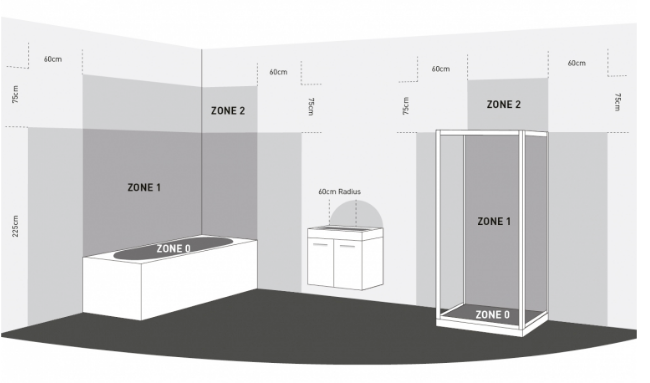What Are Bathroom Electrical Zones?

One of the first things to consider when planning to install or decorate a bathroom are bathroom electrical zones. Bathroom Zones dictate where anything electric needs to be positioned to water within a bathroom, because of the threat of electric shock. And these rules and regulations will dictate, largely, the layout of your bathroom.
What are the Wiring Regulations for Bathrooms?
Wiring regulations are a national standard for how wiring should be installed, to ensure safety and consistency throughout the UK, along with providing added assurance to consumers. British Standard (BS) 7671 is the current standard in the UK and it is a legal requirement for it to be adhered to.
The Electrical Wiring Regulations explain that “All fixed electrical installations in dwellings must legally comply with BS 7671:2008 ‘Requirements for Electrical Installations’.” The Regulations exactly divide a bathroom into separate zones, with each having specific requirements about precisely what electrical equipment can be installed and used in it.
The Zonal System

What is Zone 0?
Zone 0 is the area inside the bath or shower tray. However, if there is no shower tray then ‘Zone 0’ is 10cm high from the finished floor level and will be extended by 1.2m from the fixed shower head.
Any electrical devices allowed within Zone 0 are required to have a minimum IP Rating of IP67 and a low voltage (maximum 12 volts).
What is Zone 0’s IP Rating? – IP67
What is Zone 1?
Zone 1 in a bathroom is the same width as the bath and extends to 2.25m above the finished floor level (it is above Zone 0). Zone 1 in a shower room is the same width as the shower basin and is 2.25m from the finished floor level (also above Zone 0). Alternatively, it can be the height of the fixed shower head if the distance between the fixed shower head and the finished floor level is more than 2.25m.
If there is no shower tray, Zone 1 will be extended by 1.2m from either the fixed shower head or fixed water outlet.
Any electrical appliances fitted within Zone 1 must be a minimum of IP65, with a maximum of 12 volts. The transformer should also be located beyond Zone 2.
It should also be noted that Zone 1 does not include Zone 0.
What is Zone 1’s IP Rating? – IP65
What is Zone 2?
In a bathroom, Zone 2 is the same height as Zone 1 (2.25m), but is extended to 0.6m around, or either side of, the bath. Zone 2 in a shower room is the same. However, if there is no shower tray in the shower room, Zone 2 will be Zone 1 and Zone 1 will be 1.2m from the fixed shower head.
Furthermore, any electrical equipment fitted in Zone 2 must be at least IP44 and have a maximum of 12 volts. Like Zone 1, the transformer should be fitted beyond Zone 2.
What is Zone 2’s IP Rating? – IP44
What are the Outside Zones/Zone 3?
Outside Zones were once referred to as Zone 3. The Outsize Zone is basically anything in the bathroom or shower room that is not within zones 0-2. Portable equipment, like a hairdryer, is permitted outside Zone 2, but although it is allowed for electrical equipment to be fitted in Outside Zones without an IP number, it is always encouraged that any lights used should have a rating of at least IP44.
The space and size of zones can be limited by walls and ceilings, among other things. For more information, we recommend looking at BS 7671 with their detailed diagrams, specifically diagrams 701.1 and 701.2.
What are IP ratings?
The IP (Ingress Protection) Rating is a system that aims to provide transparency and detailed information about exactly how well an electrical appliance protects against their surroundings. For example, against the intrusion of solid objects, dust, and water, etc. The IP rating of an electrical appliance will determine what Bathroom Electrical Zone it is permitted to go in. For example, IP ratings will determine the types of lights you can use and where you can use them. It is important to know and understand the minimum IP rating requirement in bathroom zones to ensure that the appliances being fitted are safe and legal. Items which have an IP rating are lights, extractor fans and radiators, to name just a few.
IP Ratings have two digits that follow ‘IP’. The first digit refers to the appliance’s mechanical protection, e.g., against dust or other foreign bodies. The first digit is always a number between 0-6. The second digit refers to it’s protection against moisture and this number will be between 0-8. The IP Rating system shows that the higher the appliance’s IP number, the greater protection it will give against foreign bodies and water. Also worth noting: the lower the bathroom electrical zone number, the higher the IP rating will be required to be.
Please see the detailed breakdowns of each bathroom zone above for their required minimum IP rating.
Disclaimer: Please use this page for guidance only. If you would like any further information, please consult the IEEE Wiring Regulations, or speak to your electrician. It is always recommended to consult a professional and qualified individual to carry out electrical work in bathrooms.